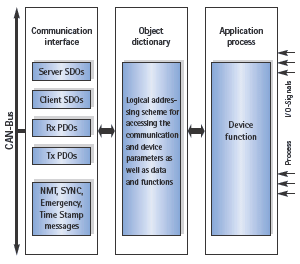The CANopen profile family is based on a "Communication Profile", which specifies the basic communication mechanisms and a number of different Device or Application Profiles which describe the most important device types such as digital and analog I/O modules, drives, programmable controllers and encoders. In these device profiles functionality, parameters and the access to process data of standard devices of the corresponding types are specified. Based on these standardized profiles devices of different manufacturers can be accessed in exactly the same manner, which again results in manufacturer independence to a large extent.
The key element of the CANopen standard is the description of the device functionality through an object dictionary.

Each entry in the object dictionary is identified via a 16 bit index and an 8 bit sub-index. The individual entries in the object dictionary provide a basis for a standardized network access to "Application Objects" of a device such as input and output signals, device parameters, device functions or network variables, as well as to "Communication Objects" which describe the communication functionality of the device.
Similar to other well-known field bus systems CANopen distinguishes two basic data transfer mechanisms: The high-speed exchange of small process data portions through so called "Process Data Objects" (PDO), and, the access to entries in the object dictionary through so called "Service Data Objects (SDO)". Process data objects are event triggered, cyclic or requested as broadcast objects without additional protocol overhead. A PDO can be used for the transmission of at most 8 bytes of data. In connection with a synchronization message, the transmission and the acceptance of PDOs can be synchronized through the entire network ("Synchronous PDOs"). The assignment of application objects to a PDO (Transmission Object) is adjustable through data structures ("PDO Mapping") within the object dictionary.
The transmission of SDOs is performed as a confirmed service with two CAN objects in the form of a logical peer-to-peer connection between two network devices. The addressing of the corresponding object dictionary entries is accomplished by specifying index and sub-index of the entry in the data field of the involved CAN frames. Transmitted data can be of unlimited length. The transmission of SDO messages involves an additional protocol overhead.
Standardized event-triggered "Emergency Messages" of high priority are reserved to report device malfunctions. A common system time can be provided through a central timing message.
Management functionality like controlling and monitoring the communication status of the nodes is achieved through a network management protocol (NMT), which is organized according to a logical master-slave relationship. Two alternative mechanisms ("Node-Guarding" and "Heartbeat") are available to implement node monitoring functionality.
IXXAT has been involved in the specification and development of higher layer CAN based protocols for more than 10 years. Among other activities, IXXAT has provided essential contributions to the specification of the CANopen standard. First implementations of the IXXAT CANopen software were available by 1995. Its membership in the CiA in combination with active cooperation with all important workgroups as well as the applied expertise gained through many projects qualifies IXXAT as one of the most competent partners available for the development of CANopen products and system solutions.
